Related Research Articles

The Eastern Orthodox Church, also called the Orthodox Church, Greek Orthodox Church, or officially the Orthodox Catholic Church, is the second-largest Christian church, with approximately 220 million baptised members. It operates as a communion of autocephalous churches, each governed by its bishops via local synods. The church has no central doctrinal or governmental authority analogous to the head of the Catholic Church. Nevertheless, the Ecumenical Patriarch of Constantinople is recognised by them as primus inter pares, a title formerly given to the patriarch of Rome. As one of the oldest surviving religious institutions in the world, the Eastern Orthodox Church has played a prominent role in the history and culture of Western Asia, the Caucasus, and Eastern and Southeastern Europe.

Eastern Christianity comprises Christian traditions and church families that originally developed during classical and late antiquity in Western Asia, Asia Minor, Eastern Europe, Southeastern Europe, the Caucasus, Northeast Africa, the Fertile Crescent and the Malabar coast of South Asia, and ephemerally parts of Persia, Central Asia and the Far East. The term does not describe a single communion or religious denomination.
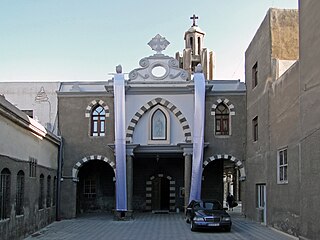
The Syriac Catholic Church is an Eastern Catholic Christian jurisdiction originating in the Levant that uses the West Syriac Rite liturgy and has many practices and rites in common with the Syriac Orthodox Church. Being one of the twenty-three Eastern Catholic Churches, the Syriac Catholic Church is a self-governed sui iuris particular church, while it is in full communion with the Holy See and with the entirety of the Roman Catholic Church.
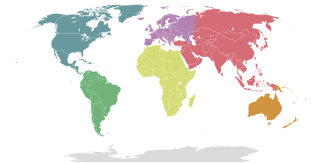
The history of Christianity in Ukraine dates back to the earliest centuries of the history of Christianity, to the Apostolic Age, with mission trips along the Black Sea and a legend of Andrew the Apostle even ascending the hills of Kyiv. The first Christian community on territory of modern Ukraine is documented as early as the 9th century with the establishment of the Metropolitanate of Gothia, which was centered in the Crimean peninsula. However, on territory of the Old Rus in Kyiv, Christianity became the dominant religion since its official acceptance in 989 by Vladimir the Great, who brought it from Byzantine Crimea and installed it as the state religion of medieval Kyivan Rus (Ruthenia), with the metropolitan see in Kyiv.
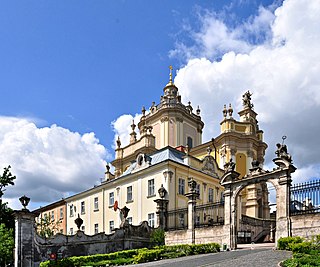
The Ukrainian Greek Catholic Church (UGCC) is a major archiepiscopal sui iuris ("autonomous") Eastern Catholic church that is based in Ukraine. As a particular church of the Catholic Church, it is in full communion with the Holy See. It is the second-largest particular church in the Catholic Church after the Latin Church. The major archbishop presides over the entire Church but is not distinguished with the patriarchal title. The incumbent Major Archbishop is Sviatoslav Shevchuk.

Dumitru Stăniloae was a Romanian Orthodox Christian priest, theologian and professor. He worked for over 45 years on a comprehensive Romanian translation of the Greek Philokalia, a collection of writings on prayer by the Church Fathers, together with the hieromonk, Arsenie Boca, who brought manuscripts from Mount Athos. His book, The Dogmatic Orthodox Theology (1978), made him one of the best-known Christian theologians of the second half of the 20th century. He also produced commentaries on earlier Christian thinkers, such as St Gregory of Nyssa, Saint Maximus the Confessor, and St Athanasius of Alexandria. He is also remembered as editor in chief of the regional orthodox newspaper Telegraful Român (1934–1945) where he imposed a nationalist and antisemitic editorial line.
The Russian Greek Catholic Church or Russian Byzantine Catholic Church is a sui iuris Byzantine Rite Eastern Catholic Church of the worldwide Catholic Church. Historically, it represents a both a movement away from the control of the Church by the State and towards the reunion of the Russian Orthodox Church with the Catholic Church. It is in full communion with and subject to the authority of the Pope of Rome as defined by Code of Canons of the Eastern Churches.
Leonid Ivanovich Feodorov was a Studite hieromonk from the Russian Greek Catholic Church, the first Exarch of the Russian Catholic Apostolic Exarchate of Russia, and a survivor of the Gulag at Solovki prison camp. He was beatified at Lviv by Pope John Paul II on 27 June 2001.
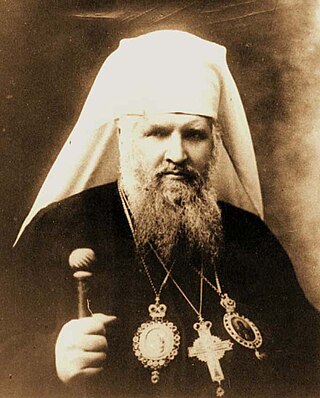
Andrey Sheptytsky, OSBM was the Greek Catholic Archbishop of Lviv and Metropolitan of Halych from 1901 until his death in 1944. His tenure in office spanned two world wars and seven political regimes: Austrian, Russian, Ukrainian, Polish, Soviet, Nazi German, and again Soviet.

Ukrainian Argentines are Argentine citizens of Ukrainian descent or Ukraine-born people who reside in Argentina. Ukrainian Argentines are an ethnic minority in Argentina. Estimates of the Ukrainian and/or Ukrainian-descended population range from 300,000 to 470,000 people. Many Ukrainian Argentines are of Jewish descent. Currently, the main concentrations of Ukrainians in Argentina are in the Greater Buenos Aires area, with at least 100,000 people of Ukrainian descent, the province of Misiones, with at least 55,000 Ukrainians, and the province of Chaco with at least 30,000 Ukrainians. In Misiones Province Ukrainians constitute approximately 9% of the province's total population. In comparison to Ukrainians in North America, the Ukrainian community in Argentina tends to be more descended from earlier waves of immigration, is poorer, more rural, has less organizational strength, and is more focused on the Church as the center of cultural identity. Most Ukrainian Argentines do not speak the Ukrainian language and have switched to Spanish, although they continue to maintain their ethnic identity.
Western Rite Orthodoxy, also called Western Orthodoxy or the Orthodox Western Rite, are congregations within the Eastern Orthodox tradition which perform their liturgy in Western forms.
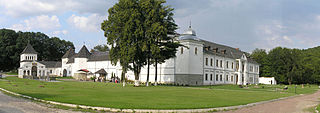
The Ukrainian Studites are a monastic order of the Ukrainian Greek Catholic Church.

Klymentiy Sheptytsky, was an archimandrite of the Order of Studite monks of the Ukrainian Greek Catholic Church and was a hieromartyr. Klymentiy has been beatified by the Catholic Church, as well as awarded the title of Righteous Among the Nations by the State of Israel for saving Jews. As effective leader of the church, he was arrested and died a prisoner of the Soviet Union.
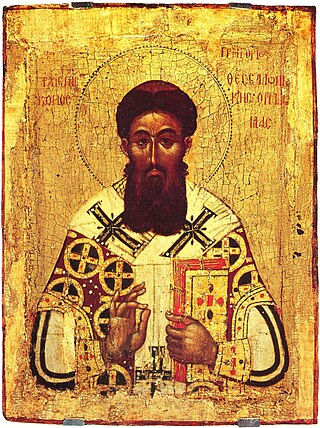
Palamism or the Palamite theology comprises the teachings of Gregory Palamas, whose writings defended the Eastern Orthodox practice of Hesychasm against the attack of Barlaam. Followers of Palamas are sometimes referred to as Palamites.
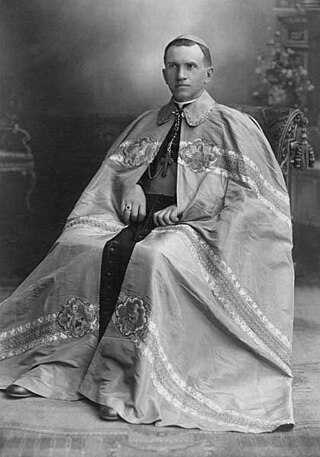
Nykyta Budka was a clergyman of the Ukrainian Greek Catholic Church who lived and worked in Austria-Hungary, Canada, Poland, and the Soviet Union. In Canada, he is noted as the first bishop of the Ukrainian Catholic Church in Canada, and was the first Eastern Catholic bishop with full jurisdiction ever appointed in the New World.
Alexander Nikolaevich Evreinov was a Russian bishop, who converted to Russian Greek Catholic Church from Russian Orthodoxy. Being a citizen with a noble origin in Saint Petersburg, Evreinov was a member of the Foreign Affairs department of the Russian nation before his conversion to the Catholic faith and ordination to the priesthood. Despite being consecrated as a bishop in 1936, Evreinov did not have any jurisdiction among Russian Catholics neither in the Soviet Union nor in the Russian diaspora. Evreinov was a member of the Russian Apostolate.

Maxim Timofeyevich Sandovich is a New Martyr and Orthodox saint. known as saint hieromartyr Maxim of Gorlice. He is the protomartyr of the Lemko people.

Sviatoslav Shevchuk is a Ukrainian Catholic prelate who has served as the Major Archbishop of Kyiv–Galicia and Primate of the Ukrainian Greek Catholic Church (UGCC) since 25 March 2011.
Alexander Ivanovich Deubner was a Christian priest in Russia. He was originally a Catholic priest of the Russian Catholic Church, then a priest of the Byzantine Rite before returning to the Catholic church. He was also a member of the Russian diaspora and died in the Gulag.

The Metropolitan Andrey Sheptytsky Institute of Eastern Christian Studies (MASI) is an autonomous unit of the Faculty of Theology at the University of St. Michael's College in the University of Toronto, Canada. It specializes in Eastern Christian studies in all its breadth. Special emphasis is placed on the tradition of the Church of Kyiv, although courses, seminars, and conferences also deal with aspects of the theology, spirituality, history, and ecclesial polity of all the Eastern Christian churches — the Eastern Orthodox, Oriental non-Chalcedonian, Assyrian, and Eastern Catholic Churches.
References
- Translated from Orthodox Pages The Transfiguration website, Biography section and Les Editions Du CERF website (French)